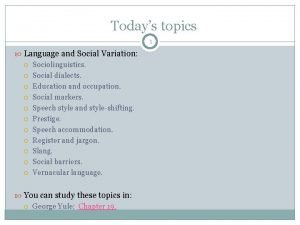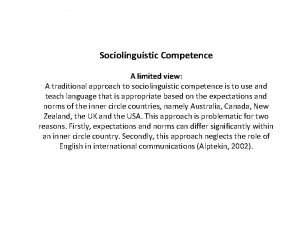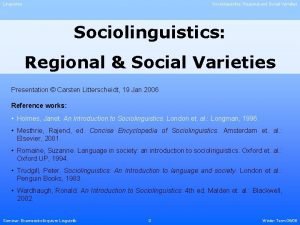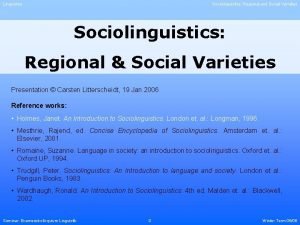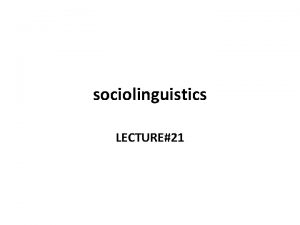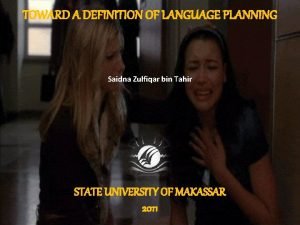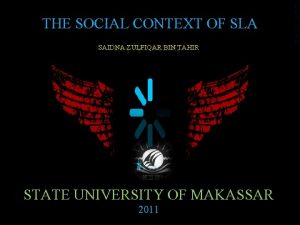SOCIOLINGUISTIC THE QUANTITATIVE STUDY OF SPEECH SAIDNA ZULFIQAR









- Slides: 9

SOCIOLINGUISTIC THE QUANTITATIVE STUDY OF SPEECH SAIDNA ZULFIQAR BIN TAHIR STATE UNIVERSITY OF MAKASSAR 2011

CONTENTS INTRODUCTION The scope of quantitative studies of speech Why Study speech quantitatively? METHODOLOGY An Example : New York An Example: Norwich An Examples: Belfast LINGUISTICS VARIABLE Types of variable Calculating scores for texts Calculating Scores for Individual and Groups

INTRODUCTION THE SCOPE The quantitative study of speech seem particularly relevant to theoretical linguistics because they involve precisely those aspects of language – sounds, word-forms and construction – which theoretical linguists consider central. In this chapter we shall review work based largely on English (albeit often non-standard English) data and concerned with variations in the form of words and constructions in spoken rather than written language. THE AIM Treatment of the data using appropriate statistical techniques. The aim to this branch of sociolinguistics, that is, ‘dialect geography’ branch of dialectology, is explicitly comparative – to compare text with one another, rather than to make some kind of ‘total’ analysis or each text without reference to others.

METHODOLOGY Methodology is both important and problematic at all stages in all sociolinguistic text study. The stages in such a study are: v. Selecting speakers, circumtances and linguistic variables v. Collecting the texts v. Identifying the linguistic variables and their variants in the texts v. Processing the figures v. Interpreting the results

EXAMPLES NEW YORK Labov wanted to try out some hypotheses he has already formulated about the using he latter use of a single linguistics variable, (r) in New York. This variable represent s the presence or absence. (r) [r] versus (r) ᴓ @ : of a consonatial contribution corresponding to the letter r in words like fair and fair, where the next sounds is not a vowel in the same word (as in vary). Labov predicted that the proposition of (r) [ᴓ/] would be highest in the speech of the older people. Since (r) [r]is an innovation) and of low status people (since a new standard (r): [r]) is the result from of influence from the high status community outside New York. NORWICH The selection of speakers was carefully planned, taking account of what was already known about the social structure of Norwich. Four areas were first selected as representation different types of housing and a range of social status. Then individuals were randomly selected from the electoral registers of these four areas and contacted at their homes to see if they would agree to be interviewed. BELFAST investigation we shall describe here is that by James and Lesley Milroy in Belfast. The methods are used are quite different from those of classical Labovian approach. As exemplified by trudgill’s Norwich study, but rather similar to those used in the late 1960 s o that by labov himself in studies of the speech of black American adolescents.

LINGUISTICS VARIABLE TYPE OF VARIABLE A linguistic variable is a linguistic item which has identifiable variants. For example, words like singing and fishing are sometimes pronounced as singin’ and fishin’. The final sound in these words may be called the linguistic variable (ng) with its two variants [º] in singing and [n] in singin’. Another example of a linguistic variable can be seen in words like farm and far. These words are sometimes given r-less pronunciations; in this case we have the linguistic variable (r) with two variants [r] and Ø (pronounced ‘zero’).

CALCULATING SCORES FOR TEXTS A score is calculated for each variable in each text, which allows texts to be compared with respect to one variable at time, which is the prime aim of quantities study of texts. To calculate the text scores of a given variable, a score is assigned to each of its variants; the score of any texts then the average of all the individual scores for the variants in that text. To take a simple example, let us say we have a variable with three variants, A B and C, and we have calculated the scores as 1 for each instance of A, 2 for each B and 3 for each C. Now assume that we have a text containing 12 A’s, 23 B’s and 75 C’s. We calculate the text score by calculating the scores of all the A’s (12 x 1 = 12), all the B’s (23 x 2 = 46), and all the C’s (75 x 3 = 225), then adding all together (12 + 46 + 225 = 283 ) and dividing the answer by the total number of variants found (i. e. 12 + 23 + 75 = 110), giving 283 110 = 2. 57. This is the score for the text concerned for this variable, and it will of course be easy to compare it directly with scores for the other texts for this same variable.

CALCULATING SCORES FOR INDIVIDUAL AND GROUPS A reliance on group scores alone conceals the amount of variation within each group. A group scores of say, 2 for some variable ranging from 1 to 3 could be produced either by all the members of the group having scores very close to 2, or by some scoring 1 and others 3. In the former case, the group average of two represent a norm around which the speech of the group members clusters, whereas it is completely meaningless or misleading in the second case. The variable is concerned with the assimilation of one vowel to another in the following syllable in words like /beckon/ ‘Do’, whose first vowel varies between [e] and [o]. Each figure represents the percentage of assimilated vowels in the speech of one speaker, and the speakers are arranged in eight columns, each representing a separate group. The groups are defined on non-linguistic grounds, on the basis of education and sex.



